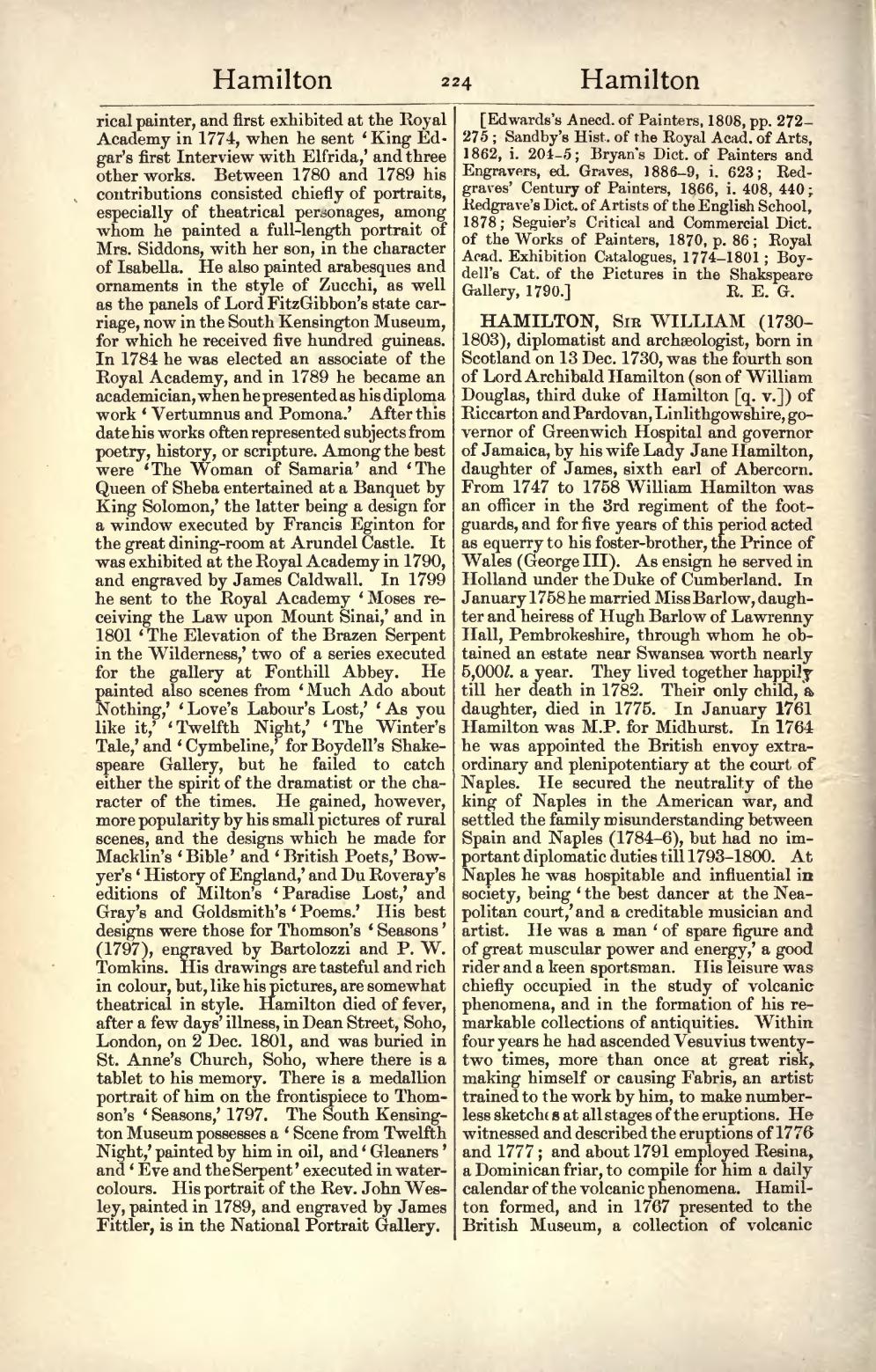rical painter, and first exhibited at the Royal Academy in 1774, when he sent 'King Edgar's first Interview with Elfrida,' and three other works. Between 1780 und 1789 his contributions consisted chiefly of portraits, especially of theatrical personages, among whom he painted a full-length portrait of Mrs. Siddons, with her son, in the character of Isabella. He also painted arabesques and ornaments in the style of Zucchi, as well as the panels of Lord FitzGibbon's state carriage, now in the South Kensington Museum, for which be received fire hundred guineas. In 1784 he was elected an associate of the Royal Academy, and in 1789 he became an academician, when he presented as his diploma work 'Vertumnus and Pomona.' After this date his works often represented subjects from poetry, history, or scripture. Among the best were 'The Woman of Samaria' and 'The Queen of Sheba entertained at a Banquet by King Solomon,' the latter being a design for a window executed by Francis Eginton for the great dining-room at Arundel Castle, It was exhibited at the Royal Academy in 1790, and engraved by James Caldwall. In 1799 he sent to the Royal Academy 'Moses receiving the Law upon Mount Sinai,' and in 1801 'The Elevation of the Brazen Serpent in the Wilderness,' two of a series executed for the gallery at Fonthill Abbey, He painted also scenes from 'Much Ado about Nothing,' 'Love's Labour's Lost,' 'As you like it' 'Twelfth Night,' 'The Winter's Tale,' and 'Cymbeline,' for Boydell's Shakespeare Gallery, but he failed to catch either the spirit of the dramatist or the character of the times. He pained, however, more popularity by his small pictures of rural scenes, and the designs which he made for Macklin'a 'Bible' and 'British Poets,' Bowyer's 'History of England,' and Du Roveray's editions of Milton's 'Paradise Lost,' and Gray's and Goldsmith's 'Poems.' His best designs were those for Thomson's 'Seasons' (1797), engraved by Bartolozzi and P. W. Tomkins. His drawings are tasteful and rich in colour, but, like his pictures, are somewhat theatrical in style. Hamilton died offerer, after a few days' illness, in Dean Street, Soho, London, on 2 Dec. 1801, and was buried in St. Anne's Church, Soho, where there is a tablet to his memory. There is a medallion portrait of him on the frontispiece to Thomson's 'Seasons,' 1797. The South Kensington Museum possesses a 'Scene from Twelfth Night,' painted by him in oil, and 'Gleaners' and 'Eve and the Serpent' executed in watercolours. His portrait of the Rev. John Wesley, painted in 1789, and engraved by James Fittler, is in the National Portrait Gallery.
[Edwards's Anecd. of Painters. 1808, pp. 272–275; Sandby's Hist. of the Royal Acad. of Arts, 1862, i. 204–5; Bryan's Dict. of Painters and Engravers, ed. Graves, 1886–9, i. 623; Redgraves' Century of Painters. 1856, i. 408, 440; Redgrave's Dict. of Artists of the English School, 1878; Seguier's Critical and Commercial Dict. of the Works of Painters. 1870, p. 86; Royal Acad. Exhibition Catalogues, 1774–1801; Boydell's Cat. of the Pictures in the Shakespeare Gallery. 1790.]
HAMILTON, Sir WILLIAM (1730–1803), diplomatist and archæologist, born in Scotland on 13 Dec. 1730, was the fourth son of Lord Archibald Hamilton (son of William Douglas, third duke of Hamilton [q. v.]) of Riccarton and Pardovan, Linlithgowshire, governor of Greenwich Hospital and governor of Jamaica, by his wife Lady Jane Hamilton, daughter of James, sixth earl of Abercorn. From 1747 to 1758 William Hamilton was an officer in the 3rd regiment of the foot-guards, and for five years of this period acted as equerry to his foster-brother, the Prince of Wales (George III). As ensign he served in Holland under the Duke of Cumberland. In January 1758 he married Miss Barlow, daughter and heiress of Hugh Barlow of Lawrenny Hall, Pembrokeshire, through whom he obtained an estate near Swansea worth nearly 5,000l. a year. They lived together happily till her death in 1782. Their only child, a daughter, died in 1775. In January 1761 Hamilton was M.P. for Midhurst. In 1764 he was appointed the British envoy extraordinary and plenipotentiary at the court of Naples. He secured the neutrality of the king of Naples in the American war, and settled the family misunderstanding between Spain and Naples (1784–6), but had no important diplomatic duties till 1793–1800. At Naples he was hospitable and influential in society, being 'the best dancer at the Neapolitan court,' and a creditable musician and artist. He was a man 'of spare figure and of great muscular power and energy,' a good rider and a keen sportsman. His leisure was chiefly occupied in the study of volcanic phenomena, and in the formation of his remarkable collections of antiquities. Within four years he had ascended Vesuvius twenty-two times, more than once at great risk, making himself or causing Fabris, an artist trained to the work by him, to make numberless sketches at all stages of the eruptions. He witnessed and described the eruptions of 1776 and 1777; and about 1791 employed Resina, a Dominican friar, to compile for him a daily calendar of the volcanic phenomena. Hamilton formed, and in 1767 presented to the British Museum, a collection of volcanic
